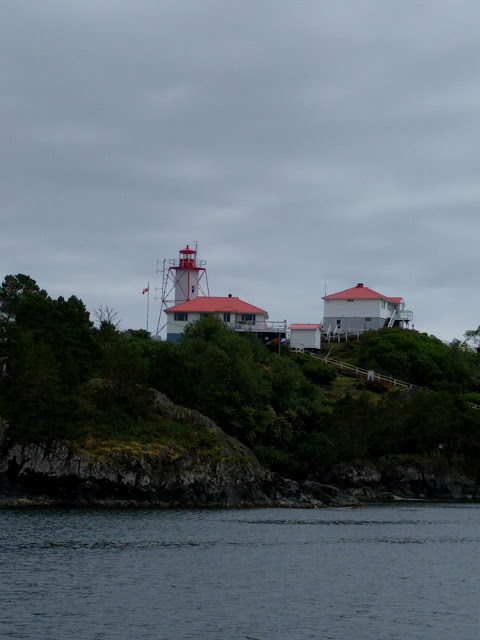Since
we are at the dock and town is just four blocks away, we walk back into town
for coffee (and internet) this morning.
We find Zoe’s Café and Bakery and order lattes and an “egg bake” to
share. Yesterday this place was teaming
with people and this morning it appears that the town is slow to wake up. We are here with just 3 or 4 other hearty
folks. I work on the blog but there is
no internet here. She suggests a café up
the hill.
We
finish our coffee and decide to go on the walk to the lighthouse (the very walk
we missed doing yesterday). It is
about 1 km from the café to the start of the trail and another 2.2 km of
trail. The walk is stunning. A mix of feeling like you might be in
Monterey (wind swept trees), the Oregon Coast (big rocks and sweeping waves)
and somewhere altogether different. The
trail is extremely well kept and we meet many travelers along the way.
We
walk back into town to find the Blue Café where we will have our second
breakfast (blueberry pancakes to share) and use the internet.
From
Uclulet we are headed to Effingham Bay in the Outer Broken Islands. The forecast for the Strait of Juan de Fuca
has winds approaching 40 knots until Monday.
Our plan is to explore Nootka Sound.
Uclulet is a place I would enjoy returning.
The
Broken Islands are a rock strewn archipeligo with dozens of small anchorages
although a great many of them appear to be good for temporary stays where there
is someone on watch. We wind our way
into Effingham Bay avoiding many rocks along the way and set the anchor. The wind is from the west and this bay is
perhaps least protected from the west.
We watch a smaller boat pull up there anchor and move out of the bay to
a tiny inlet on the opposite shore. They
put down their anchor close to shore and take a stern line to shore. We consider our options, including staying
where we are. We have a good anchor and
300 feet of chain that have never yet let us down. Still, neither of us wants to spend the night
worrying. We opt to move five miles to
Joe’s Bay. This is an almost completely
sheltered lagoon with several very narrow entrances. We enter at low tide (just less that 4 feet
tonight) and carefully skirt rocks and reefs.
As we enter the bay, we see that we are not alone. There are six sailboats already at anchor. We quickly join the sailboats at rest in the
bay.
This
area is part of the Pacific Rim National Park and we sit on the aft deck and
watch the kayakers bringing their boats to shore. There must be a campground just out of
sight. We are snug and comfortable on
the boat. Perhaps my days of sleeping on
rocky beaches in the rain are behind me.
Since
we learned that the word Chug is a derogatory reference to First Nation’s
People, from time to time my mind wanders on what to do (if anything) about the
name of our boat – “Chug.” So far, only
a small handful of ideas but nothing is jumping out. There is an Alaska Mountain Range named
Chugach (Choo-ach) – that could preserve a bit of “Chug”. Another option could be Hamlet. Barrie always says operating a boat is a lot
like owning your own small city – on the boat you have the water department,
the sewage department, the electric works, etc.
This morning I was thinking about our friends Retired Adm. Scott &
Mindy Van Buskirk and that led to thinking about Adm. Scott Swift who followed
our friend Scott into the position of Adm. Strike Group 9 and 7th
Fleet. Scott Swift’s call sign was Not-so
(as in Not-so Swift). All of which
caused me to think about “Knot-so Swift” as yet another possible name. When you have a boat with a single diesel
engine and a full-displacement hull you move efficiently but slowly. Our max speed is just about 7 knots (or just
over 8 mph) and that makes our boat Knot-so Swift. I suppose we will continue to let the ideas
percolate.
















